
What is Korean BBQ? All You Need To Know!
In this article, we breakdown Korean barbecue, from the meats used, the sauces that flavor the meal, and the sides you can enjoy with it, both side bites and drinks.
With the spread of the Korean wave (aka Hallyu), South Korea continues to export its cultural commodities all over the world. From entertainment like K-Pop, K-Drama, and K-Movies to Cosmetics and beauty products, South Korea really is gaining a lot of global attention. Along with the rise of Korean cultural commodities the interest in Korean food cuisine is rising. And what is more popular than the Korean Barbecue?
Korean Barbecue is seen in almost every Korean show as a social and celebratory meal with friends, family, or co-workers. They cheerfully gather around an open grill and cook together. Seeing them dig into the mouthwatering meal makes you want to try it too.
Let’s get you prepared to make the most of your Korean BBQ experience, either in a restaurant or at home.
What is a Korean Barbecue?
Korean Barbecue (or K-BBQ), locally known as gogi-gui (고기구이 in Hangul), is the Korean style of grilling thin slices of meat like beef, pork, and chicken over a charcoal or gas grill. The grill is often in-built into the dining table with a grill mesh or portable tabletop stove with a grilling pan.
The meat dishes are served raw, and the customers have to grill it themselves before they can feast! The meat of Korean BBQ may or may not be marinated.
One of the most popular meats associated with Korean barbecue is Bulgogi, which is literally translated as ‘Fire meat.’ It’s just thinly sliced meat marinated in a soy sauce marinade. How did Bulgogi become one of Korea’s staple household dishes? Keep reading to find out!
There are numerous ways to enjoy a Korean barbecue. You can eat the meat straight off the grill, or you can have it as small bite-sized parcels where the meat is dipped in ssamjang sauce and wrapped in lettuce or perilla leaves.
Korean BBQ is served alongside side dishes (Banchan) and alcoholic drinks like Beer, Soju, Makgeolli, or Wine.
Before we talk about the different aspects of Korean BBQ like the meats, marinating and dipping sauces, and side dishes, let us look at the historical background of this dish.
Looking for a source of High-Quality Meat?
Here are the Fresh Meat Suppliers we trust.
What are the Origins Of Korean BBQ?
Korean barbecue has fascinating origins that tie-in deeply with its culture.
Let’s start off by talking about the most famous dish, Bulgogi, which represents Korean cuisine and its nation.
Bulgogi is actually an umbrella term for two slightly different dishes: one that’s brothy, and another that’s roasted over a grill.
Bulgogi’s origins can be traced back to a dish called maekjeok from the Goguryeo era (37 B.C. to 668 A.D.). Maekjeok was pre-marinated roast meat on a skewer that was famous in the land.
However, as Buddhism spread in the Korean Peninsula, eating meat was banned, and Korea became dependent on its agricultural produce. Only small pockets of tribes living in the fringes ate meat.
The practice of eating meat returned with the Mongol invasion of Korea around 1230–1271 AD., Maekjeok made a comeback as this meat could be preserved when supplies dwindled. But interestingly, six centuries of vegetarian cuisine was so ingrained into the Korean cuisine that it became a part of the meal in the form of Banchan – the side dishes served along with every Korean meal.
Through the different eras of Korean history, Maekjeok slowly turned into Seoryamyeok – a brothy dish of marinated beef soaked in cold water. Seoryamyeok, in turn, developed into a royal court dish called Neobiani, which was made of thick, flat, and wide cuts of meat cooked over a charcoal fire. Neobiani was popular among the Korean royalty during the Joseon dynasty(1392-1910).
How Neobiani evolved to become Bulgogi is a bit complicated. Socio-cultural factors like commercial meat production in the 1920s, the Japanese colonization, and the Korean War (1950-1953) all contributed to the change.
Korea was predominantly an agricultural state, so the consumption of meat, especially beef, was not seen as an economically viable option since cows were required for plowing. But with the rise of bulgogi–specialized restaurants in major urban cities, the production of beef increased.
Through the Japanese rule between 1910 to 1945, beef shortages increased the price, resulting in the decreased popularity of bulgogi. But as US meat-slicing machines were introduced during the Korean War, preparing meat as thinly sliced pieces became quick and easy, which contributed to the rebound of bulgogi.
But surprisingly, until recently, bulgogi was considered as a celebration dish that was eaten only on special occasions like birthdays, weddings, or for guests. This was because beef was considered a luxury product because of its high prices in South Korea compared to the rest of the world. Even today, It’s still three times more expensive than beef in the USA!
Other than Bulgogi, another popular dish in South Korea is Samgyeopsal or grilled pork belly. It has become an indispensable part of contemporary Korean cuisine. Koreans have even dedicated the 3rd of March to samgyeopsal as Samgyeopsal day! But this was not always a famous dish.
Until the 70s, eating pork was linked with lethal parasites and greying of hair. Even if pork was used for cooking, it was rarely grilled. Instead, it was added to stew due to the scarcity of meat.
Just like how bulgogi became popular with grilling on the rise in the 70s, the same was the case with samgyeopsal. Pork became a cheaper alternative to beef and so was widely consumed by the people.
This was because the export-oriented industry for meat was booming in South Korea from the 1970s well into the 80s and 90s. Parts like tenderloin and sirloin with low fat were exported, but fatty parts like pork belly remained in the domestic market because of weak demand in foreign markets. This cheap meat became a rising star among the working class, with the increase of industrialization and internationalization of the Korean economy.
Now as Korean living standards have improved and the Korean economy is booming, people still love samgyeopsal. It has ingrained itself into contemporary Korean culture.
Did you know?
North Korea does not have a practice of roasting pork belly. It is exclusive to South Korea because of a lot of socio-economic factors that played a significant role in pork belly or samgyeopsal.
What Are the Elements of K-BBQ?
Korean Barbecue includes three elements – Meat, Sauces, and Sides. Here is a video so that you can visually take it in:
Korean BBQ Meat: The ‘Hero’ of K-BBQ
| MEATS | K-BBQ NAMES WHEN MARINATED | K-BBQ NAMES WHEN NOT MARINATED |
| Beef |
Bulgogi( thinly sliced sirloin, ribeye, or brisket) Galbi (short ribs) Jumulleok (short steak) |
Deungsim (Sirloin or Ribeye Steak) Chadolbaegi (Beef Brisket Strips) Usamgyeop (Beef Belly Slices) Andeungsi (Beef Tenderloin) Chimasal (Flank Steak) |
| Pork | Dwaeji bulgogi (spicy pork bulgogi) |
Samgyeopsal (Pork Belly) Moksal ( Pork Chop) Kalmaegisal (Skirt Meat Strips) |
| Chicken | Bul Dak (Hot & Spicy Chicken) | Dak Gui ( Grilled Chicken) |
Did you know?
The US has around 22 beef cuts, the French and English have about 35 cuts, but the Koreans have a whopping 120 beef cuts! This is because they utilize most parts, even organs, head, and tail.
There are about 50 popular meat types, enough to fill a whole book! So for our sake, let’s stick to the most popular ones!
BEEF
BEEF
- Bulgogi
We have talked so much about the evolution of bulgogi! Now let’s learn about how it is made.
‘Bul’ means fire, and ‘Gogi’ means meat, so the literal translation is ‘fire meat.’ It actually refers to the method of cooking, that is, grilling the meat over a fire. The meat used can be beef, pork, lamb, or chicken. The most common bulgogi is made with beef.
Bulgogi is usually made from thinly sliced beef cuts like sirloin, ribeye, or brisket. It is marinated in a sweet soy marinade hours in advance and taken out when it needs to be cooked on the grill.
The marinade recipe varies from place to place, and even family to family depending on personal taste. But it’s base ingredients are soy sauce, sugar, and sesame oil. Other ingredients like garlic and Asian pears are traditionally used as tenderizers. Pineapple, kiwi, and onions can be used as well.
- Galbi or Kalbi
Galbi or Galbi-gui refers to the grilled meat made from beef (or pork) short ribs and is marinated in a soy sauce marinade.
When galbi is used on its own, it usually refers to beef. It is also called bulgalbi if it is cooked over a fire. Galbi can also be made with pork ribs or chicken, and it is called dwaeji galbi or dak galbi respectively, to emphasize the main ingredient.
The only difference between galbi and bulgogi is the different types of meat cut used. Galbi is made of short ribs, whereas bulgogi is made of prime meat cuts like sirloin and tenderloin.
The marinade has a similar recipe to the bulgogi marinade. It is made with ingredients like soy sauce, sugar, sesame oil, rice wine, garlic, Asian pear, white onions, and green onions.
Looking for a source of High-Quality Meat?
Here are the Fresh Meat Suppliers we trust.
PORK
PORK
- Dwaeji Bulgogi
This is the second-most popular bulgogi after beef. Dwaeji bulgogi or daeji bulgogi is a spicy pork-based barbecue dish similar to bulgogi. Instead of beef, meat cuts like thinly sliced pork loin are used.
The meat is marinated in a soy-based gochujang sauce. Ingredients like soy sauce, sesame oil, garlic, sugar, ginger roots, rice wine, and gochujang are used to
- Samgyeopsal
Samgyeopsal or Samgyupsal is a popular dish that is enjoyed at home or served in Korean restaurants specialized in pork meat.
It is served with leafy sides like lettuce or perilla leaves to wrap samgyeopsal with. You can add a dab of ssamjang sauce (which we will talk about in more detail below) and stuff it in your mouth for a heavenly taste.
Samgyeopsal consists of thick, fatty pieces of pork belly that are grilled. The meat is neither seasoned or marinated.
It is usually grilled with other items like kimchi, mushrooms, and garlic. They are all combined and eaten together.
Pitmaster Tip:
Gochujang or red chili paste is a popular condiment in Korean cuisine. It is a thick and spicy-sweet sauce made from red chile pepper flakes, fermented soybeans, glutinous rice (also known as sticky rice), and salt.
CHICKEN

1. Bul Dak
If red meat isn’t for you, you can always try Bul Dak, a popular chicken barbecue dish, especially among the younger generation in Korea.
Bul Dak is marinated with a hot & sweet sauce, grilled over an open fire. Then it is plated on a skillet, topped with cheese as well as various herbs.
Most restaurants serve this with varying levels of spiciness and served alongside vegetables like sweet radishes, salads, and onions.
It can be either made with bite-sized chicken breast pieces or bone-in chicken thighs.
It is a common Anju. Anju are dishes consumed with alcohol.
Looking for a source of High-Quality Meat?
Here are the Fresh Meat Suppliers we trust.
Korean BBQ SAUCE: The ‘Heroine’ of K-BBQ
Ssamjang Sauce

Ssamjang sauce is an ever-present dish in Korean barbecue. Just as a Korean hero is incomplete without his heroine, K-BBQ can never be complete without Ssamjang sauce.
Ssamjang is a no-cook dipping sauce made of a mixture of gochujang (red chili pepper paste), doenjang (fermented soybean paste), and other seasonings.
It has a spicy, salty flavor with an assertive umami flavor from the fermented soybean paste.
Ssamjang translates to ‘wrapped thick sauce,’ and that is precisely its purpose.
Leaves like lettuces and perilla leaves are slathered with ssamjang sauce, which then is wrapped around barbecued pieces of meat and made into bite-sized parcels to be stuffed into your mouth.
The amount of ssamjang sauce used depends on the kind of meat you use.
Unmarinated meats like Samgyeopsal and lighter marinated meats like beef galbi can take up more sauce as opposed to dwaeji bulgogi, which is already full of flavor.
Korean BBQ Sides: The ‘Star-Appearances’ of K-BBQ
Korean BBQ has an array of side dishes that are often more famous than K-BBQ itself. Korean side dishes, aka ‘Banchan,’ allow you to indulge your palate with a variety of flavors.
You can combine it with your barbecued meat in a ssam (small bite-sized parcels of meat, Bachan, and Ssamjang sauce, wrapped in lettuce and perilla leaves), or enjoy it separately.
Although a complete list of banchan would be too much for this article, here are some of the most common banchan:
Kimchi

Kimchi holds the limelight for being one of the most popular Korean dishes. It is also a household staple, and you can spot it alongside just about any Korean main course.
It is a traditional side dish made from salted and fermented vegetables, seasoned with chili powder, scallions, garlic, and ginger. Napa cabbage and sweet radish are the vegetables typically used.
It might be a tad bit too sour for some at the first bite, but slowly chew it, and you will be pleased with the satisfying spiciness that follows.
It complements the meat served in Korean barbecue very well. It’s best paired with samgyeopsal or grilled pork belly.
Hobak Bokkeum or Stir-Fried Zucchini
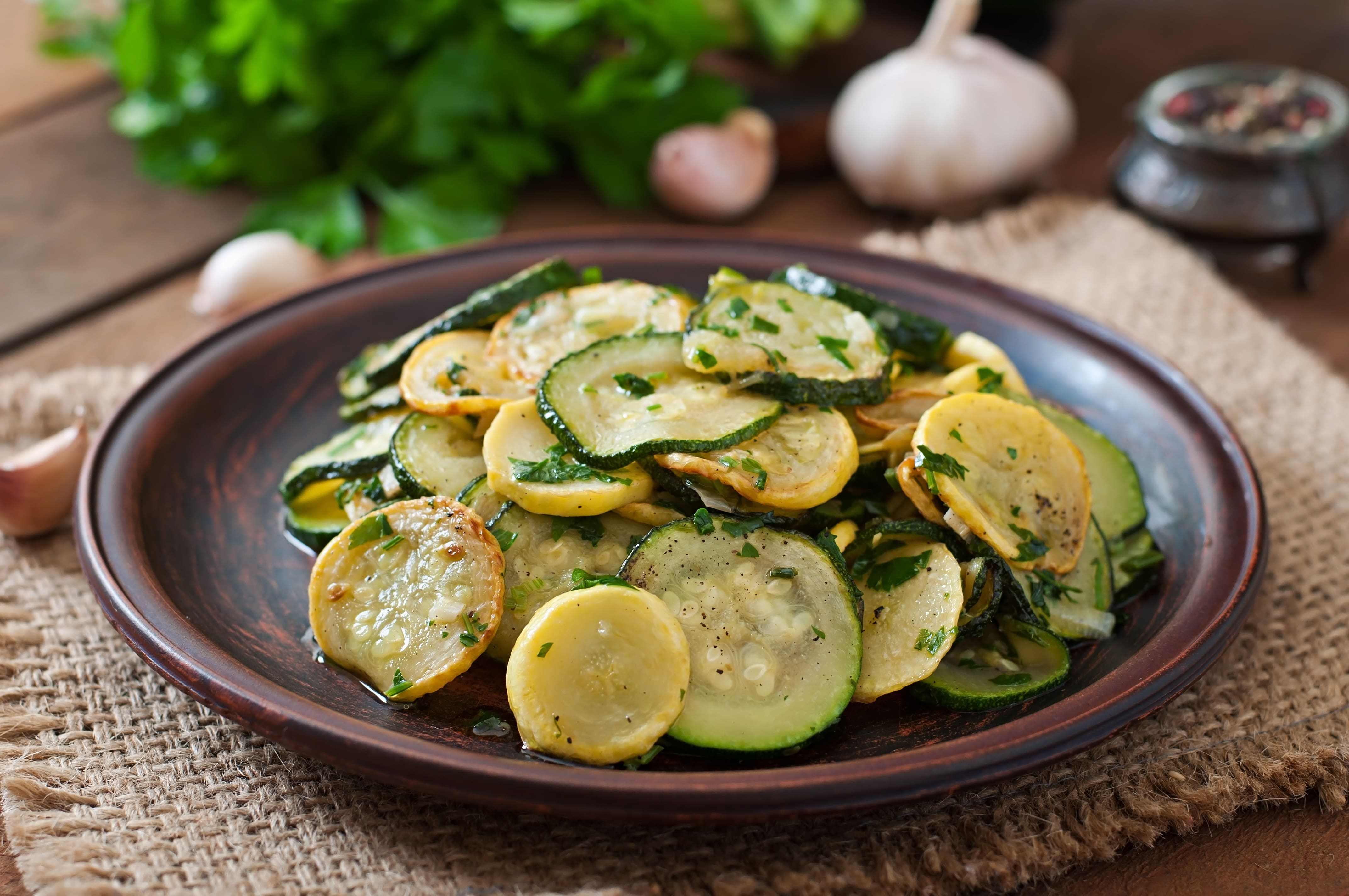
Hobak Bokkeum or stir-fried zucchini is a summer side dish that is served alongside meats like bulgogi and galbi.
It’s diced and seasoned with saeujeot (or saewujeot), which is salted and fermented shrimp sauce and garnished with sesame seeds.
Hobak Bokkeum has a tangy taste.
Seaweed
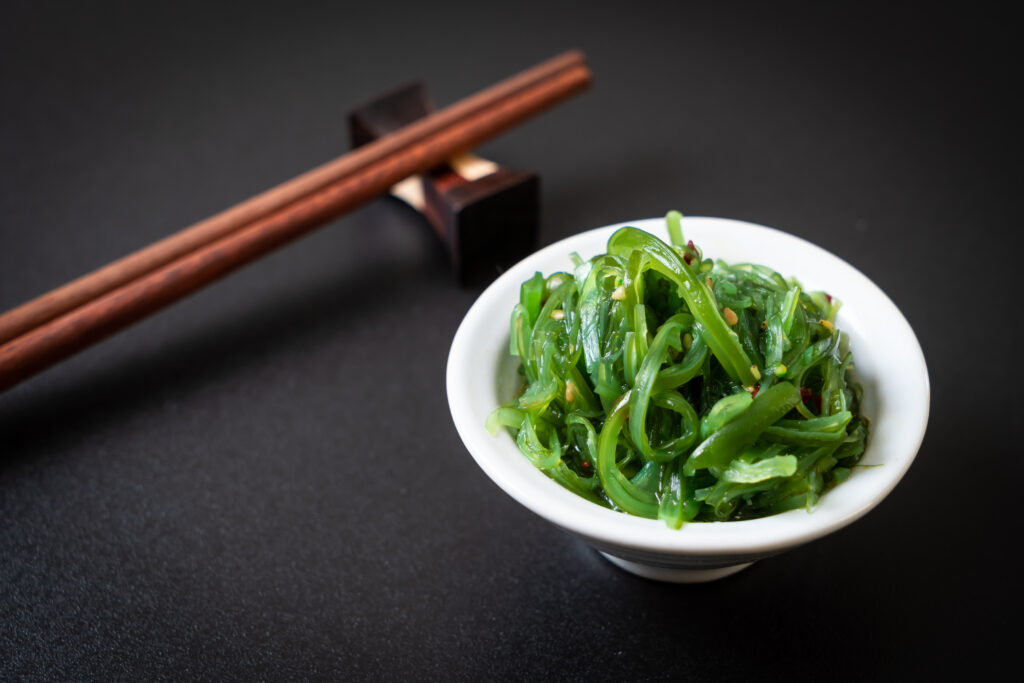
Seaweed comes in many forms, from vinegary salads to dried salted chips. It is rich in calcium, vitamins and is also a good source of iron.
It can be had with the meat or with the rice that comes along with the barbecue.
Eomuk Bokkeum or Stir-Fried Fishcake
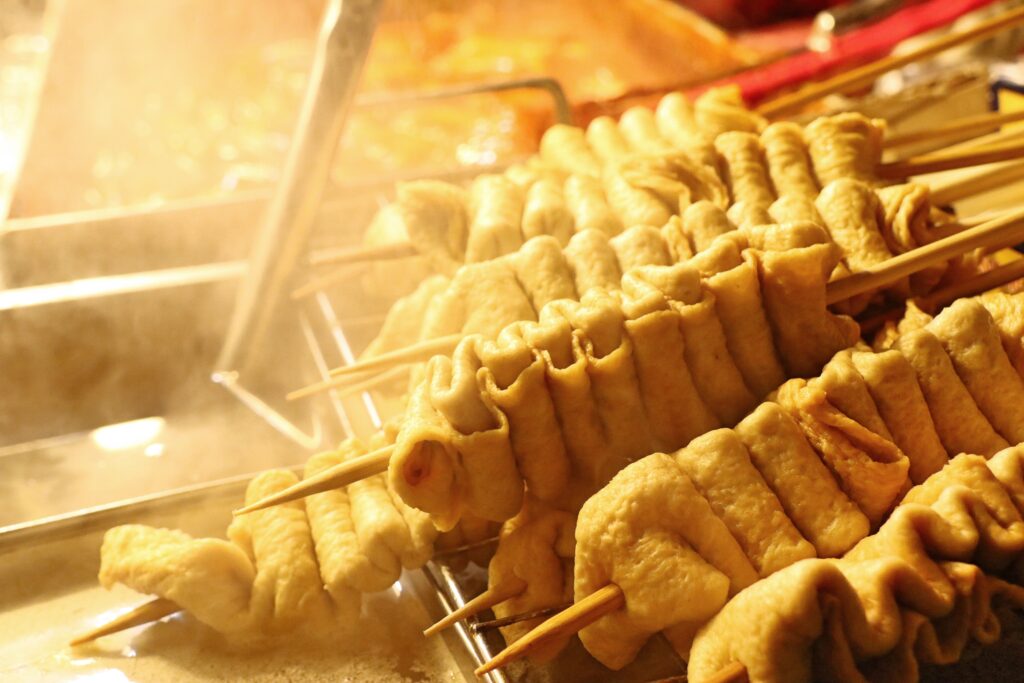
Bokkeum means stir-fried dishes.
One of the popular ones is eomuk bokkeum or stir-fries fishcakes.
It is a delicious dish with a sweet, salty, spicy, and chewy taste.
Musaengchae or Spicy Radish Salad

This dish is made from Korean radish and seasoned with red pepper chili flakes (gochugaru), garlic, and saeujeot.
The result is a refreshingly crunchy dish with a spicy kick.
There is also a sweet and sour option, which isn’t as spicy. It uses sugar, vinegar, and salt with small quantities of the spicy red pepper chili flakes.
How to Enjoy Korean BBQ like a Local? (Pairing + Etiquettes)
How to Eat a Ssam at a Korean BBQ?
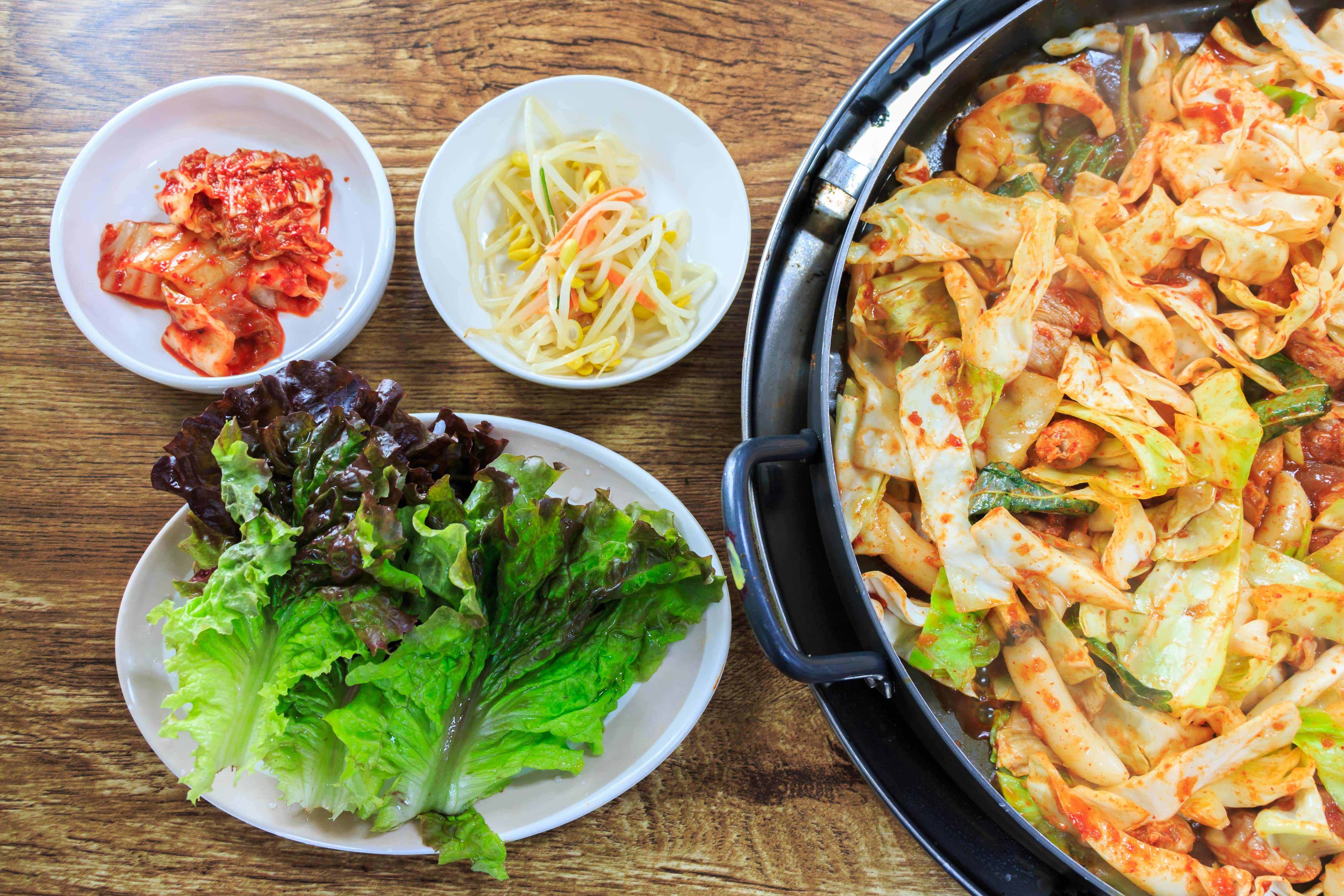
Ssam literally translates to ‘wrapping’ in English – that’s what they do!
Ssam are small bite-sized parcels made with lettuce or perilla leaves to eat and enjoy your Korean barbecued meat.
Perilla leaves are also sold as sesame leaves in Korean markets.
You can add banchan, ssamjang sauce, and more to make the best out of your ssam.
Garnishes like sesame seeds, Korean chilis, garlic, and scallions can be added to top it off. Don’t get too greedy while stacking though!
HOW TO WRAP SSAM LIKE A PRO
- Take a lettuce leaf in your hand. Add sesame leaf over it.
- Add a piece of barbecued meat, hot from the grill.
- Add a dab of ssamjang sauce (adjust according to the meat and personal taste)
- Add your favorite sides. If you are having samgyeopsal or grilled pork belly, add kimchi, because you can never go wrong with a pork and kimchi combination.
- Wrap the whole thing into a neat little package.
- Eat the whole thing in one bite! Don’t take half bites; otherwise, it gets messy! (I told you not to get greedy when adding the ingredients, didn’t I?)
What Are the Drinks Available at a Korean BBQ?

Barbecuing is a social event in South Korea, and no gathering is complete without drinks to wash the meat down! Drinking is a collective activity that comes with a lot of etiquettes, which we will discuss below.
You can pair your barbecuing experience with Beer, Soju, Makgeolli, or Wine. If you don’t drink alcohol, you can always pair it with carbonated drinks and fruit juices.
Soju is a Korean rice wine. It is a colorless, vodka-like drink with an alcohol content of around 20%. A shot glass is used to drink soju. It is an excellent pair with foods like samgyeopsal or grilled pork belly. It is cheap and one of South Korea’s favorite drinks.
Makgeolli is turbid rice wine. Its alcohol content is much lower than soju, around 6-7%. Makgeolli is an excellent pair with spicy food, as it acts as a good palate cleanser.
What are Korean BBQ Etiquettes?
Eating Etiquettes
- Korean always respect those older than them or higher in rank. When sitting down, make sure that your elders have a seat first.
- When eating, it is common courtesy to let your elders start first and enjoy the meal before you. That’s why Koreans make an effort to know other’s ages early on so that they can interact with you without disrespecting you.
- Time your eating speed and finishing. You don’t want to finish too early or too late as it can look bad. Also, make sure to finish everything on your plate.
- Don’t hold back on the eating, especially if you are with the older generation. They will be more than happy to see you eat as much as you can hold because they come from a time when food was scarce and will be more than happy to see you enjoy your food.
- Koreans traditionally use chopsticks and spoons to eat. Keep in mind to use one utensil at a time. Don’t hold both in one hand. Chopstick is used to make the ssam and eat the banchan, whereas a spoon is used to eat rice, soup, and stew.
Drinking Etiquettes>
- Never pour drinks for yourself! Always keep in mind to pour for others and let others pour for you.
- When pouring for someone, make sure to keep both hands on the bottle.
- If you are on the receiving end, make sure to cup the shot glass with both hands.
- It is polite to turn your face slightly away from others when drinking, whilst covering your mouth with your hand. This is not always enforced, but it is considered polite,
If you find these rules overwhelming, don’t worry, they aren’t strictly enforced! If you are a foreigner, you get some slack. They may even be impressed when you make an effort to follow their etiquette.
How to Make Korean Barbecue at Home?
Because Korean BBQ is naturally a communal and celebratory meal, it’s a great way to have a party at home with friends or family over.
But you definitely need to prepare for it well in advance. If you can find a Korean supermarket, you can practically get everything ready-made.
1. Take the Grill Out
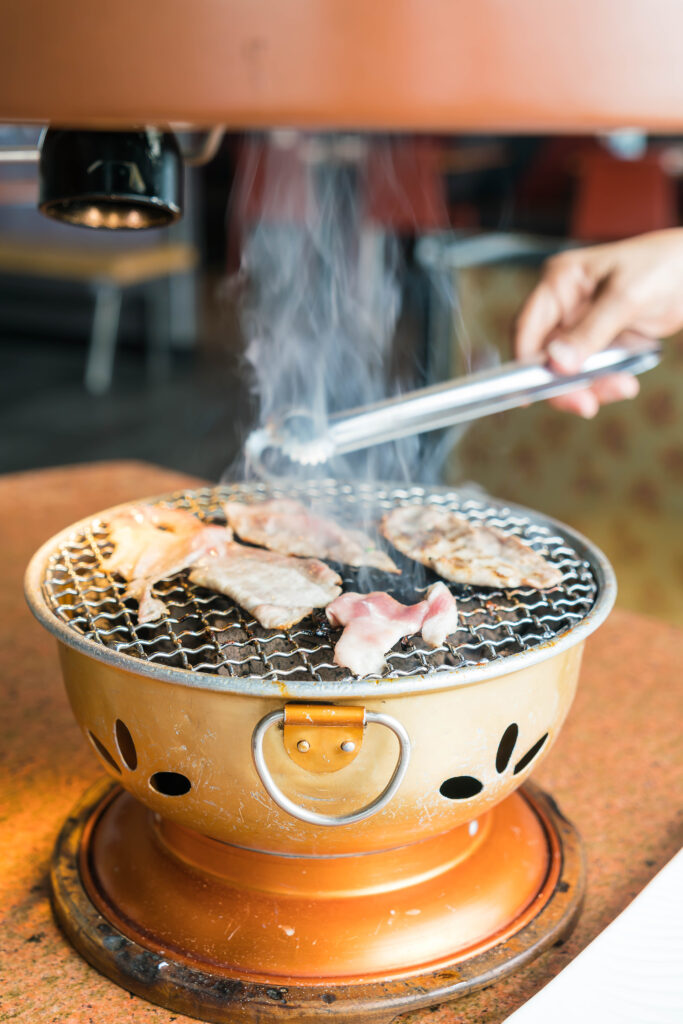
You can use a round grilling plate and a gas-fueled tabletop burner for cooking the meat or can use your charcoal grill, but make sure you have a wire mesh grill; otherwise, the small pieces will fall out. You may want to ensure that
Traditionally the grill is placed in the middle of the table, and everyone sits around it. But if you can’t arrange that, that’s okay! You can have a designated griller who will cook the food for all to enjoy.
2. Buying Meat and Preparing.
For Bulgogi, you can use skirt steak, hanger steak, and even sirloin tips. Make sure to ask your butcher to cut it in thin slices. If not, you can always freeze the meat and slice it thin (keep in mind it does take a bit of practice).
For Bulgogi marinade, you can try this recipe to marinate your meat in advance.
You can also add sliced pork belly (Samgyeopsal) as it does not need marination.
For other meats, you can take a look here to find recipes to cook it.
Looking for a source of High-Quality Meat?
Here are the Fresh Meat Suppliers we trust.
3. Preparing Banchan and Other Sides.
Make sure to buy leaves like Lettuce and sesame leaves to make ssam. Don’t forget to cook rice to eat along with your barbecue.
For banchan like kimchi and dried seaweed, you can buy them in Korean markets. You can always try simpler recipes at home to have a variety on the table.
4. Get Grilling and Enjoy!

When grilling, it is a good idea to grill non-marinated meat before moving on to marinated meat because:
- It enhances your Korean Barbecue experience by starting with meats like samgyeopsal.
- The marinade from the marinated meat might get burnt and stick to the grill, making the non-marinated meat experience unenjoyable.
You can go beast mode by eating the meat straight off the grill, or make a ssam to enjoy your meat. If you feel stuffed, slow down and eat some sides or rice.
Conclusion
Now that we have gone from history to the breakdown, it’s time to head to the grill and put your knowledge into practice!
Go ahead and explore the different cuts of meat and flavors that come with Korean barbecue and never be scared to try something new. Make sure to grab some family members and friends to have a meal you won’t forget!
You can even sneakily share this article with them if you want them to prepare a Korean barbecue for you!
Jal Meokkesseumnida! (Bon appetit!)
Subscribe to BBQanswers.com to step up your barbecue game!
























